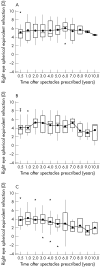Longitudinal changes in the spherical equivalent refractive error of children with accommodative esotropia
- PMID: 16488962
- PMCID: PMC1856935
- DOI: 10.1136/bjo.2005.078105
Longitudinal changes in the spherical equivalent refractive error of children with accommodative esotropia
Abstract
Aim: To assess the longitudinal changes in the spherical equivalent (SE) refractive errors of children with accommodative esotropia as a function of the age when glasses were prescribed.
Methods: Refractive errors were followed longitudinally for 126 children with accommodative esotropia for a mean of 4.4 (SD 2.5) years. Cycloplegic refractions were performed using an autorefractor for older children and retinoscopy for younger children. The refractive data were analysed for three groups of children based on their age at the time spectacles were prescribed.
Results: The initial SE refractive error was age dependent (<2 years, 5.1 (1.9) D; 2-<4 years, 4.2 (1.9) D; 4-8 years, 3.8 (1.7) D). Children in all age groups had an initial increase in their SE refractive error, followed by a later decrease; however, the greatest decrease occurred in the patients in the oldest age group. The SE refractive error peaked 1 year after spectacles were prescribed for the children 4-8 years of age versus 6 years after spectacles were prescribed for the children less than 2 years of age.
Conclusion: Longitudinal changes in SE refractive error for children with accommodative esotropia vary as a function of their age when spectacle wear is initiated.
Similar articles
-
Longitudinal changes in the cylinder power of children with accommodative esotropia.J AAPOS. 2007 Feb;11(1):55-9. doi: 10.1016/j.jaapos.2006.09.024. J AAPOS. 2007. PMID: 17307685
-
Long-term changes in refractive error in patients with accommodative esotropia.Ophthalmology. 2010 Nov;117(11):2196-207.e1. doi: 10.1016/j.ophtha.2010.02.019. Epub 2010 Jun 26. Ophthalmology. 2010. PMID: 20580093
-
Changes in refractive error in patients with accommodative esotropia after being weaned from hyperopic correction.Br J Ophthalmol. 2015 May;99(5):680-4. doi: 10.1136/bjophthalmol-2014-305991. Epub 2014 Nov 21. Br J Ophthalmol. 2015. PMID: 25416183
-
Emmetropization in accommodative esotropia: an update and review.Compr Ophthalmol Update. 2006 May-Jun;7(3):145-9. Compr Ophthalmol Update. 2006. PMID: 16882403 Review.
-
Accommodative esotropia.Ophthalmol Clin North Am. 2001 Sep;14(3):425-32. doi: 10.1016/s0896-1549(05)70240-6. Ophthalmol Clin North Am. 2001. PMID: 11705142 Review.
Cited by
-
Accommodative esotropia who needs spectacles for good ocular alignment after refractive shift below +2.00 diopters.Korean J Ophthalmol. 2014 Oct;28(5):417-22. doi: 10.3341/kjo.2014.28.5.417. Epub 2014 Sep 18. Korean J Ophthalmol. 2014. PMID: 25276084 Free PMC article.
-
Comparison of Longitudinal Changes in Refractive Error of Hyperopic Children with or without Refractive Accommodative Esotropia.Diagnostics (Basel). 2021 Aug 26;11(9):1547. doi: 10.3390/diagnostics11091547. Diagnostics (Basel). 2021. PMID: 34573889 Free PMC article.
-
Why do only some hyperopes become strabismic?Invest Ophthalmol Vis Sci. 2013 Jul 24;54(7):4941-55. doi: 10.1167/iovs.12-10670. Invest Ophthalmol Vis Sci. 2013. PMID: 23883788 Free PMC article. Review.
-
Long-term development of refractive error in refractive, nonrefractive and partially accommodative esotropia.PLoS One. 2018 Sep 24;13(9):e0204396. doi: 10.1371/journal.pone.0204396. eCollection 2018. PLoS One. 2018. PMID: 30248135 Free PMC article.
-
Changes in refractive errors related to spectacle correction of hyperopia.PLoS One. 2014 Nov 5;9(11):e110663. doi: 10.1371/journal.pone.0110663. eCollection 2014. PLoS One. 2014. PMID: 25372594 Free PMC article.
References
-
- Swan K C. Accommodative esotropia long range follow‐up. Ophthalmology 1983901141–1145. - PubMed
-
- Schaeffel F, Glasser A, Howland H C. Accommodation, refractive error and eye growth in chicks. Vis Res 198828639–657. - PubMed
-
- Hung L ‐ F, Crawford M L J, Smith E L. Spectacle lenses alter eye growth and the refractive status of young monkeys. Nat Med 19951761–765. - PubMed
Publication types
MeSH terms
Grants and funding
LinkOut - more resources
Full Text Sources
Medical



